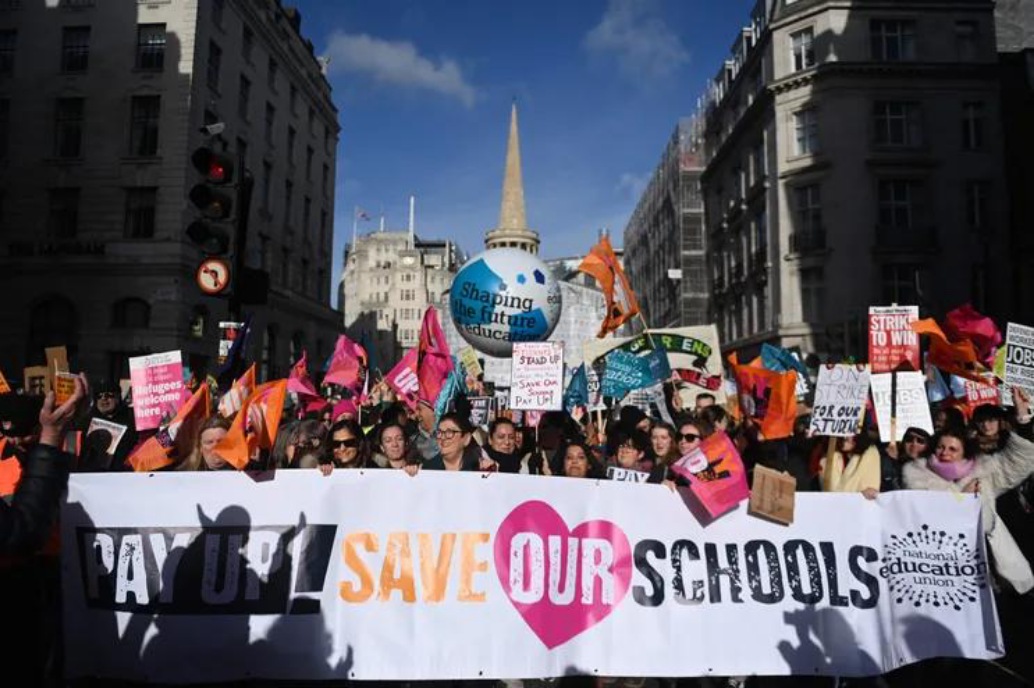Por Ronney Turus – LIS Reino Unido
El 1 de febrero fue un gran éxito para los trabajadores y sindicatos del Reino Unido. Fue catalogado como el día de acción industrial más masivo en una década por las masas. Más de medio millón de huelguistas estuvieron en los piquetes y decenas de miles protestaron en todo el país. 350.000 maestros de escuela, 100.000 funcionarios públicos, 70.000 profesores universitarios y trabajadores ferroviarios se unieron a los piquetes ese día. Habrá más huelgas en los próximos días, incluido del Servicio Nacional de Salud, ferrocarriles, maestros, conferencistas y trabajadores de la cultura (museos) a lo largo de febrero.
Fue un espectáculo impresionante de solidaridad y resistencia ver a los trabajadores, sus familias, alumnos, estudiantes universitarios y el público unirse y respaldar a los huelguistas. Había una sensación de empoderamiento para contraatacar. Esta fue una prueba de una mayor acción coordinada y escalada que será imprescindible para obtener salarios decentes, resistir los trabajos precarios y derrotar las brutales leyes antisindicales que se están simplificando en el parlamento.
Las leyes antihuelgas prevén un «nivel mínimo de servicio» que será una condición para los servicios ferroviarios, bomberos, ambulancias, servicios públicos, salud, educación y trabajadores nucleares. Los miembros del sindicato a quienes sus jefes les pidieron que trabajaran bajo esta ley pero se negaron a hacerlo podrían perder sus trabajos. Los patrones podrían presentar una orden judicial para detener las huelgas o buscar una compensación de los sindicatos y los trabajadores si las huelgas continúan. Los patrones nombrarían a los trabajadores que quieren que trabajen en un día de huelga. Por ejemplo, se le podría pedir a un representante sindical militante que trabaje el día de la huelga, lo que desmoralizaría y socavaría la huelga.
El Reino Unido ya tiene una de las leyes sindicales más antidemocráticas. Por ejemplo, hay más de 500.000 profesores en Inglaterra. Si los sindicatos de maestros quisieran hacer una huelga legal, al menos la mitad de los 500 mil maestros tendrían que votar y la mitad de ellos debería votar a favor de la huelga. Si uno aplica este algoritmo a las elecciones parlamentarias en el Reino Unido, sólo un puñado de miembros del parlamento habrían sido elegidos.
Los gobiernos del Reino Unido, laboristas y conservadores, implementaron un programa de austeridad contra los trabajadores y los pobres desde la crisis financiera de 2008. El aumento salarial siempre ha estado por debajo de la inflación desde entonces para todos los trabajadores. Los maestros han perdido un 23 por ciento en términos reales desde 2010, y el personal de apoyo en las escuelas un 27 por ciento durante el mismo período. Las enfermeras han perdido el 20 por ciento de sus salarios debido a la inflación desde 2010. Y nuevamente, un profesor universitario ha perdido alrededor del 23 por ciento en términos reales. El costo de vida, que consiste en un aumento en los precios de la energía, los alimentos, las hipotecas, los impuestos individuales y los combustibles, aumentó un 11% sólo en 2022. Este es el aumento de precios más alto en 41 años. Si bien los maestros y las enfermeras no pueden permitirse comprar alimentos y dependen de los bancos de alimentos y pagar sus facturas de energía, las ganancias corporativas se han multiplicado por ocho. El gobierno británico puede culpar a la guerra en Ucrania, el Brexit, los precios de la energía, la inflación, etc., pero la austeridad fue una elección. Mientras los salarios se estancaban, las ganancias se disparaban. Los ricos evitaban pagar sus impuestos.
El primero de febrero fue un paso correcto y en la dirección correcta, pero no es suficiente. Ahora, los trabajadores y los sindicatos tienen que intensificar una huelga coordinada para todos los trabajadores. La RMT está considerando una nueva oferta de las compañías ferroviarias. A las enfermeras se les podría ofrecer un contrato un poco mejor, pero aún por debajo de la inflación, para evitar que hagan huelga. Los profesores se convertirán en chivos expiatorios, como siempre sucede en el Reino Unido. Cada capa de trabajadores será desactivada una por una en abril o mayo.
Ha habido falta de voluntad por parte de algunos sindicatos para coordinar y escalar la huelga. Si los sindicatos no pueden cumplir su propósito de defender a sus miembros en una acción colectiva, será el último clavo en el ataúd del sindicalismo en Inglaterra. Margaret Thatcher cortó las alas de los sindicatos en los años 80. Ahora, al gobierno le gustaría amputar a los sindicatos de las rodillas para abajo.
El gobierno británico está débil, dividido y paralizado por conflictos internos y asuntos personales. Una huelga general no solo derrocaría al gobierno sino que abriría las vías para mejorar la lucha y los logros de la clase trabajadora. Algunos activistas abogan por el 15 de marzo como el día de acción coordinada y escalada. Una manifestación nacional el 11 de marzo y luego un día de acción coordinado y escalado sacudirá el establecimiento que ya patina sobre hielo delgado. ¿Puede suceder eso? Los dirigentes sindicales han girado y retorcido el movimiento, han bajado y se han agachado hasta ahora. Todavía pueden socavar el movimiento, pero saben que esta vez dañarían a los sindicatos por mucho tiempo. ¿Pueden tomar ese riesgo?




